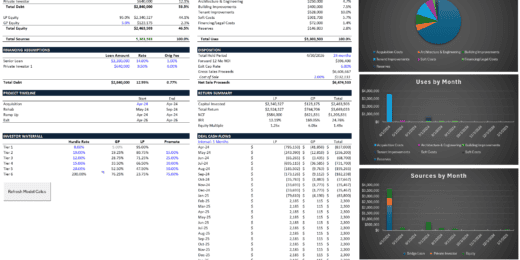Why do you need a Financial Model?

Financial models have become the standard financial-decision making tools used entrepreneurs, financial analysts, investors, business executives, banks and other stakeholders in business. Financial modeling takes time, effort and industry-know-how and uses a rational way of looking at things free from emotion and personal attachment generally found to the business by entrepreneurs and founders.
So, let us review the different reasons respectively use cases why financial models are needed:
- Starting a new Business: Whenever building something new, there are risks involved. One way to reduce the risks is to do some solid planning and think the business concept through. For Startups, this means especially preparing a financial plan as funds are tight and there are many questions which need to be answered: How much funding will be needed, when will we achieve break-even, how can we monetize our platform, etc. So building a financial model can become a valuable planning tool for Startups.
- Raising funding from Investors: One of the triggers why a financial model is prepared relates to fundraising. Many Startups will have to consider the option of raising equity financing from investors such as Business Angels or Venture Capitalists. Investors are very critical people as their money is on the line. They will want to make a careful investment decision. Therefore, they normally will want to thoroughly review the investment case, understand the risks and upside potential before agreeing to inject money. This will require the business’ management team to prepare a detailed and well substantiated financial plan which is credible enough to convince capital providers to go ahead with the contemplated investment. Normally the required calculations will require many details to be considered, therefore a financial model in form of a spreadsheet model will be needed.
- Valuing a business: Another reason is to value a business. Most famous example is the Discounted Cash Flow (DCF) Method, a forward looking valuation method of the Income Approach. Future free cash flows are discounted to their present values by taking into account the risk and opportunity costs by using an appropriate discount rate. A DCF model requires a 5 year business plan. To prepare the required financial plan, normally a detailed financial model spreadsheet in Excel is needed to perform the required calculations. As the financial plan is highly subjective, it is very important provide transparency about the assumptions, calculations and valuation method used. The best way to do this is to build a financial model in Excel.
- Evaluating a new investment: Here we change the perpective from a company’s management or owners to an investor or buyer point of view. The buyer might be less interested in the valuation output, what he needs to understand are the returns, the risks involved and the upside of the proposed investment. This normally requires to focus the analysis on the Internal Rate of Return rather than the Net Present Value. IRR analysis typically either requires the calculation of the cash flows available to equity shareholders or a cash-in/cash-out consideration based on the investment amount, dividends, change in shareholder loans and associated interest and pro-rate stake in the exit value.
In order to understand the investment proposition, investors many times will build their own financial model as they want to exactly see how the projected profits and cash flows are calculated. They also might want to play around with the model to understand certain scenarios such as worst case and best case scenario. Lastly they might also want to compare the investment with past similar investment cases or current second best alternatives.
- Making informed financial decisions: Financial decisions decide over the allocation of funds. Every decision will have financial consequences, can either lead to a loss or a gain. Therefore, it is fully rationale to carefully think about every decision and run the required calculations. A solid analysis will require a financial model as basis for decision-making. Financial models are used to substantiate and justify financial decisions rationally and transparently. They provide a tool to quantify which scenario offers the highest financial benefit to shareholders (or stakeholders).
- Financial Analysis and Understanding a Business: Developing a financial model helps to analyze a business in a rationale and data-driven manner. Preparing a financial model allows the easy calculation of financial ratios since the calculations in the spreadsheet can be linked dynamically to the underlying accounts. Performing thorough financial analysis can identify problems with the business, offer new insights and allow a better understanding of the business. Whenever there is something strange with a company’s financials or not understood, having a solid financial model as analytical framework can offer tremendous help in finding the problem and solution.
- Business Planning: A business plan analyzes the market, competitors, the Unique Selling Proposition, Strategy, products, and describes the plan going forward. A business plan will become more credible when properly quantified in form of a financial plan. Business plans many times are developed or requested in order to become more clear or agree among the management team how the plan going forward has to look like. A financial model quantifies the business plan in number and comes up with the corresponding financial projections over the next 5 years or more. A financial model, therefore, lies at the heart of any good and meaningful business plan and goes beyond a pure next year’s budget. Many times, the term “Business Plan” actually refers to the 5-year financial projections.
- Turnaround and Restructuring Scenarios: In the case of a Turnaround or Restructuring situation, a new business plan will be required including the quantifications in form of a financial plan. Entering into a restructuring is an important decision and in order to maximize the chances of success a solid strategy and some thorough planning will be needed. In many cases, a restructuring will require the allocation of capital. Therefore, a financial model as basis for such decisions is needed to justify the decision towards the board or shareholders.
- Bank Financing: Established business very often will have to raise funding from banks for their investment or business expansion projects. Apart from collateral, banks typically focuse on specific financial ratios which are important to meet their lending criteria. Normally, these are Debt/EBITDA ratios, Debt/Equity ratio, and debt service coverage ratios. A financial model can model the expected financial ratios and their change when assuming a different business scenario.
As you can see there are a number of good reasons why you need a financial model. Spending time and effort to develop a financial model is a signal towards any investor, bank, or entrepreneur that you work professionally.
With this list, we hope that we were able to give you some good reasons and use cases why you need a financial model.













